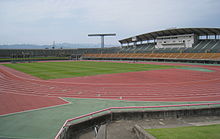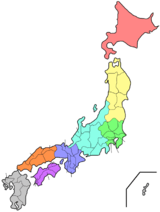Toyama Prefecture
Toyama Prefecture (富山県, Toyama-ken) is a prefecture of Japan located in the Chūbu region of Honshu.[2] Toyama Prefecture has a population of 1,044,588 (1 June 2019) and has a geographic area of 4,247.61 km² (1,640.01 sq mi). Toyama Prefecture borders Ishikawa Prefecture to the west, Gifu Prefecture to the south, Nagano Prefecture to the east, and Niigata Prefecture to the northeast.
Toyama Prefecture 富山県 | |
|---|---|
| Japanese transcription(s) | |
| • Japanese | 富山県 |
| • Rōmaji | Toyama-ken |
 Flag  Symbol | |
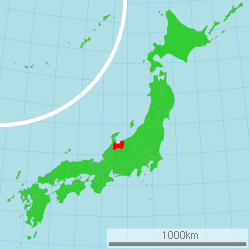 | |
| Coordinates: 36°43′N 137°9′E | |
| Country | Japan |
| Region | Chūbu (Hokuriku) |
| Island | Honshu |
| Capital | Toyama |
| Subdivisions | Districts: 2, Municipalities: 15 |
| Government | |
| • Governor | Takakazu Ishii |
| Area | |
| • Total | 4,247.61 km2 (1,640.01 sq mi) |
| Area rank | 33rd |
| Population (June 1, 2019) | |
| • Total | 1,044,588 |
| • Rank | 37th |
| • Density | 250/km2 (640/sq mi) |
| ISO 3166 code | JP-16 |
| Website | pref.toyama.jp |
| Symbols | |
| Bird | Ptarmigan[1] |
| Fish | Japanese amberjack Pasiphaea japonica Firefly squid[1] |
| Flower | Tulip (Tulipa)[1] |
| Tree | Tateyama Cedar (Cryptomeria japonica)[1] |
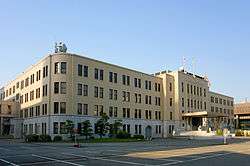
Toyama is the capital and largest city of Toyama Prefecture, with other major cities including Takaoka, Imizu, and Nanto.[3] Toyama Prefecture is part of the historic Hokuriku region, and the majority of prefecture's population lives on Toyama Bay, one of the largest bays in Japan. Toyama Prefecture is the leading industrial prefecture on the Japan Sea coast and has the advantage of cheap electricity from abundant hydroelectric resources. Toyama Prefecture contains the only known glaciers in East Asia outside of Russia, first recognized in 2012, and 30% of the prefecture's area is designated as national parks.[4]
History
Historically, Toyama Prefecture was Etchū Province.[5] Following the abolition of the han system in 1871, Etchū Province was renamed Niikawa Prefecture, but Imizu District was given to Nanao Prefecture. In 1872 Imizu District was returned by the new Ishikawa Prefecture.
In 1876, Niikawa Prefecture was merged into Ishikawa Prefecture but the merger was void in 1881 and the area was re-established as Toyama Prefecture.
The Itai-itai disease occurred in Toyama around 1950.
Geography

Toyama Prefecture is bordered by Ishikawa Prefecture to the west, Niigata to the northeast, Nagano to the southeast, Gifu to the south and Sea of Japan to the north.
As of April 1, 2012, 30% of the total land area of the prefecture was designated as Natural Parks, namely the Chūbu-Sangaku and Hakusan National Parks; Noto Hantō Quasi-National Park; and six Prefectural Natural Parks.[6]
Municipalities
Due to the mergers in the 2000s, Toyama has the fewest municipalities of any prefecture in Japan with 10 cities, 2 districts, 4 towns, and 1 village (before the mergers took place, the prefecture had 9 cities, 18 towns, and 8 villages).
Cities
Ten cities are located in Toyama Prefecture:
Towns and villages
These are the towns and villages in each district:
Mergers
List of governors of Toyama Prefecture (from 1947)
This is a list of governors of Toyama with their titles.
- 19 April, 1947–15 November, 1947: Tetsuji Tachi (館哲二)
- 16 November, 1947-30 September, 1956: Takekuni Takatsuji (高辻武邦)
- 1 October, 1956–1 December, 1969: Minoru Yoshida (吉田実)
- 30 December, 1969-18 September, 1980: Kokichi Nakata (中田幸吉)
- 11 November, 1980-8 November, 2004: Yutaka Nakaoki (中沖豊)
- 9 November, 2004-present: Takakazu Ishii (石井隆一)
Economy
Agriculture
In 2014 Toyama contributed approximately 2.5% of Japan's rice production[7] and makes use of abundant water sources originating from Mount Tate. It also has many fisheries along its Sea of Japan coastline.
Manufacturing
Toyama is famous for its historical pharmaceutical industry which remains a top manufacturing industry in the prefecture in terms of manufacturing shipment value followed by electronic parts and devices (industrial robots, general machinery, etc.), and metal products (aluminum, copper etc.) manufacturing.
Energy
Kurobe Dam generates electricity for the Kansai Electric Power Company. It is located on the Kurobe River in Toyama Prefecture.
Demographics
Per Japanese census data,[8] and[9], Toyama has had gradual population increase after 1950 and gradual population decline at 1960-1970 and 21st century
| Year | Pop. | ±% |
|---|---|---|
| 1920 | 724,000 | — |
| 1930 | 779,000 | +7.6% |
| 1940 | 823,000 | +5.6% |
| 1950 | 1,009,000 | +22.6% |
| 1960 | 1,033,000 | +2.4% |
| 1970 | 1,030,000 | −0.3% |
| 1980 | 1,103,000 | +7.1% |
| 1990 | 1,120,000 | +1.5% |
| 2000 | 1,120,851 | +0.1% |
| 2010 | 1,093,247 | −2.5% |
| 2020 | 1,044,588 | −4.5% |
Transportation
Rail
Tokyo: 2 hr 7 min via Hokuriku Shinkansen
Osaka: 3 hr via Hokuriku Shinkansen and Thunderbird Limited Express
- The Hokuriku Shinkansen line is scheduled to extend to Osaka in the future, and will shorten the Osaka-Toyama trip to approximately 1 hr 40 min.
Air
- Toyama Airport (TOY)
International
- Shanghai: 2 hr 30 min via Shanghai Airlines
- Dalian: 2 hr 30 min via China Southern Airlines
- Seoul: 1 hr 50 min via Asiana Airlines
- Vladivostok: 2 hr 40 min via Vladivostok Airlines
Culture
UNESCO World Heritage Cultural Sites
Gokayama Historical Village (Nanto City)
National Treasures of Japan
Zuiryū-ji Temple (Takaoka City)
Festivals
Spring
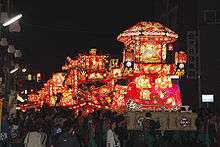
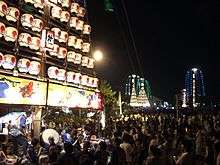
- All Japan Chindon Competition (Toyama City (Toyama Castle Park), Mid April
- Tonami Tulip Fair (Tonami City), May
- Marumage Festival (Himi City), May 17
Summer
- Sassa Narimasa Sengoku Era Festival (Toyama City), Late July
- Japan Wildlife Film Festival (Toyama Prefecture), Early August
Fall
- Toyama Festival (Toyama City), Sept. 1
- Owara Kaze no Bon (Toyama City (Yatsuo Area)), Sept. 1-3
Winter
- Nanto Toga Soba Festival (Nanto City (Toga Village Area)), Mid Feb.
Regional Foods
- Trout Sushi (Masu Zushi)
- White Shrimp (Shiro Ebi)
- Matured Yellow Tail (Buri)
- Firefly Squid (Hotaru Ika)
- Fish Paste (Kamaboko)
Regional sake
- Tateyama (立山)
- Narimasa (成政)
- Masuizumi (満寿泉)
- Sanshoraku (三笑楽)
Sports
The sports teams listed below are based in Toyama.
Football (soccer)
Basketball
Baseball
- Toyama Thunderbirds (Toyama City)
Rugby Union
- Takaoka Mariners (Takaoka)
Tourism
- Tateyama Kurobe Alpine Route
- kurobe Gorge Railway
- Unazuki Onsen
- Gokayama(UNESCO World Heritage Site)
- Mitsui Outlet Park, Hokuriku Oyabe
International Links





Notes
- 富山県の魅力・観光>シンボル. Toyama Prefectural website (in Japanese). Toyama Prefecture. Retrieved 9 September 2011.
- Nussbaum, Louis-Frédéric. (2005). "Toyama prefecture" in Japan Encyclopedia, p. 991, p. 991, at Google Books; "Hokuriku" at p. 344, p. 344, at Google Books.
- Nussbaum, "Toyama" at p. 991, p. 991, at Google Books.
- Matsutani, Minoru (April 6, 2012). "First glaciers in Japan recognised". The Japan Times. Retrieved May 20, 2012.
- Nussbaum, "Provinces and prefectures" at p. 780, p. 780, at Google Books.
- "General overview of area figures for Natural Parks by prefecture" (PDF). Ministry of the Environment. Retrieved 29 June 2012.
- "米の生産 〔2014年〕" (in Japanese). Retrieved May 11, 2015.
- Toyama 1995-2020 population statistics
- Toyama 1920-2000 population statistics
- "Andhra Pradesh inks pact with Toyama Prefecture". The Hindu. December 29, 2015. Retrieved February 17, 2019.
References
- Nussbaum, Louis-Frédéric and Käthe Roth. (2005). Japan encyclopedia. Cambridge: Harvard University Press. ISBN 978-0-674-01753-5; OCLC 58053128
External links
| Wikimedia Commons has media related to Toyama prefecture. |
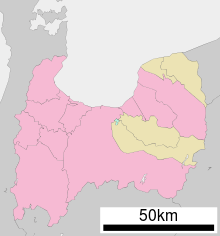
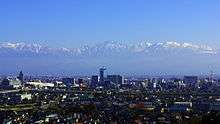
.jpg)
